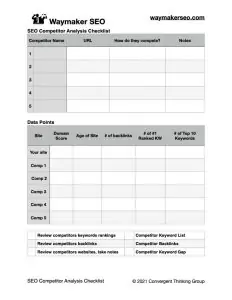SEO Competitor Analysis Checklist
This page will help you understand how to assess competitors with an SEO Competitor Analysis Checklist.
A significant facet of Search Engine Optimization (SEO) is vigorous competition from other websites.
You need to know the competitive landscape, even if your website has a clean website setup, optimized content, and a decent amount of backlinks.
What competitors should I consider for a Competitive Analysis?
The first thing to do is write out the competitors you know are active in your target market. Start with the business that directly competes. They sell a very similar product or service in the same market or adjacent market. Write out their business names, their products/services, and look them up on the web.
If your business has multiple products or services, you want to identify competing sites by the various competitive markets. For example, if you are a diner that offers a sit-down breakfast and at lunch offers burritos. Your competition would be breakfast places (market one) and burrito shops (market two).
Next, write out a list of businesses that you know that sell a substitute product or service. Example: You sell coffee through a local coffee shop; you may want to list the local tea shops or gift shops that sell tea. Another example is if you are a CPA, you may want to list out the area's local financial planners or tax consultants.
Once you have a list of competitors, you can begin to start the SEO competitor analysis.
How do you analyze an SEO competitor?
I would suggest the phases below to get you started.
Of course, the first step is to run an analysis on your website so you will be able to compare effectively.
I would also suggest starting with five competitors.
Phase 1: Look at your competitors' websites - Get some context
Start with going to a competitor's website. Look at how they have their website setup. Look for keywords and phrases that stand out. Pay close attention to headers, images, bold and italicized words. Look at the links they have on their website and where those links point to, whether it's internal links/pages or external sites. Ask yourself a few questions:
- What is the purpose of these pages?
- Who are they targeting?
- Is the content engaging?
- Are there clear "next steps" to take from this page?
- How is this different from my site?
Once you have the context for your competitor's site next, you want to head into an SEO tool to analyze their website.
Phase 2: Use SEO tools to get some data (SEO Factors)
Once you have the context for your competitor's sites, you want to start running reports on the various websites listed. Here are some SEO factors you should consider:
- Age of the site - Older websites have some authority from age
- Keyword Rankings - What words are they ranked for, and what is the rank position for those words
- Page Rankings - which pages keep showing up in the ranks
- Site Speed - How fast is the website loading up
- Backlinks - What backlinks do your competitors have
- Domain Strength/Authority - Depending on the SEO tool, they have a way to score a website
- Keyword Concentration and Word usage - How have they set up their pages with keywords
This information will help you understand your competitors' positions. Now you want to compare the data.
Phase 3: Compare the data
List out your competitors' websites and the data points you captured and compare them to your website. How do they measure up?
I included a Checklist Below.
How do you conduct a competitive SEO audit?
To conduct a competitive SEO Audit, you need to make sure you are comparing similar data points. You will need to combine the data with what you have observed. There are several SEO tools that you can use to get data for your Analysis. Whichever software you choose, compare your site on the following data points:
- Age of the site - Older sites tend to have natural authority, and, all things being equal, older sites would rank better. Fortunately, not all websites are engaged in SEO efforts.
- Backlinks - Check the number and quality of backlinks. A website with more backlinks from quality sites will be seen as more authoritative and subsequently better ranked.
- Keywords Rankings - Check your competitors' ranks. See which words and phrases they are ranked #1 and the words positioned on the first page, i.e., Ranks 1-10. Note how many keywords rank in #1 and Top 10.
- Domain Authority/Strength - Whichever SEO tool you use, they have some rank/value they place on a website.
- Keyword Intersection - Which keywords are your competitors using that you are using, which words are they using that you are not ranked for or are not using?
Once you have these data points for each SEO Competitor, put them in a spreadsheet with the domain on the left, and the various data points in the columns. You now can see how your website is matching up. I've provided a sample format below.
What are the six steps of competitive Analysis?
- List out your competitors - Direct Competition, Similar Competition, and those that offer substitutes.
- Review their websites - Get context, remember data is just one facet
- Get SEO information on your site - Use this as a template for the data you want for the next step
- Pull the same data on your competitors - Now, you can compare similar points
- Compare Results - Note where there are differences and the gaps
- Research the differences - Using the comparison data, see where competitors exceed your effort. Analyze the gaps.
What information should be in the SEO Competitor Analysis?
If you are hiring someone to provide competitor analysis, they should include the following:
- A clear list of competitors URLs
- A rank/score in the form of "Domain Authority/Strength."
- Age of site
- # of backlinks
- Keyword Rankings for specific keywords
- Backlink information - Competitors inventory, or sample, of their backlinks
- Competitors Keywords - List of words the competitors are using for SEO with keyword Gaps
- A list of suggested competitors
- Additional insights that inform shows how a competitor is competing with your website
What action do I take with the Analysis?
The data and information you receive should help inform an SEO strategy and inform your broader marketing efforts. Here are a few suggestions:
Age of Site
"Age of site" is a factor you can't beat, all things being equal, save for a time machine to go back and start your website before your competitor. If you have a younger website, you can "win" by building more authority for your website. Just because a website is aged, it doesn't mean it has domain authority.
Backlinks
If your competitor has more backlinks, you want to pay attention to the gap between how many they have and what you have. The older the website, generally, the more backlinks they have. If you see that most of your competitors have thousands of more backlinks, you may want to be more intentional in obtaining backlinks. However, not all backlinks are valuable. Stick to quality backlinks over quantity of low-value irrelevant backlinks.
Keywords
This one is tricky. If your site is outranked for specific keywords, consider optimizing particular pages for particular keywords. If your website does not have those exact phrases, consider adding that content to your website. If you are "not ranked" for keywords, you see that your competitors are ranked, then consider adding new content to your site, utilizing those words.
Rankings
Understanding your position allows you to make changes. Use these rankings to assess how the changes you are taking effect. Watch for competitors that start closing ranks on your keywords. It means they might have done some analysis and are using similar words.

